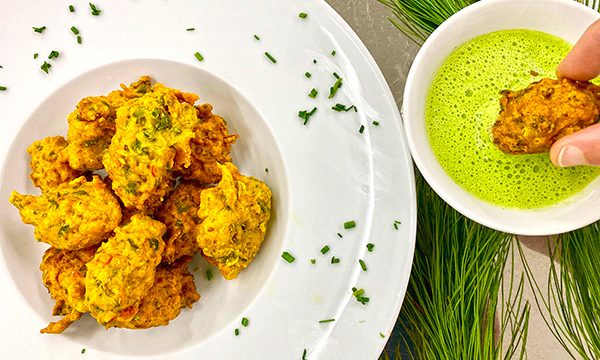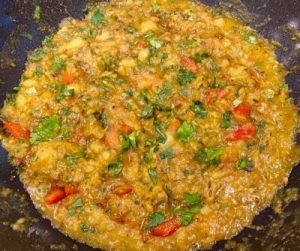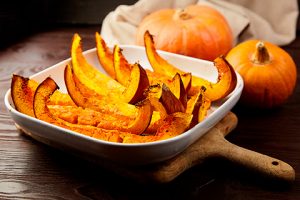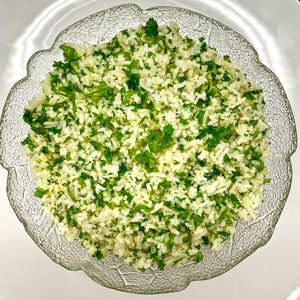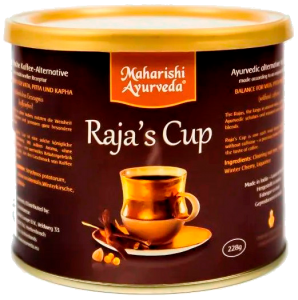There’s no need to forget about Ayurveda when it comes to the Christmas dinner! To prove it, we have put together a tasty Christmas menu for you.
The menu opens with an appetizer:
Vegetable Pakoras with Mint DipFor the main course you will have:
Tomato-Potato Curry
Pumpkin dish from the oven for autumn
and wintertime
Rice with Parsley
Chutney of Persimmon and KiwiA delicious dessert follows:
Spelt Tartlets with Berries and CardamomAs you know, Ayurveda recommends having
this delicious menu as early in the evening as
possible, so that you can then celebrate with
your dear ones, feeling light and unburdened.We hope you’ll enjoy the preparation
and wish you: Bon appétit!
Appetizer: Vegetable Pakoras with Mint Dip
Vegetable Pakoras
Ingredients for 4 persons:
- 100 g carrots
- 100 g cauliflower/romanesco
- 100 g potatoes
- 50 g spinach
- one small onion (optional)
- 1 clove of minced garlic (optional)
- 100–130 g chickpea flour
- ½ tsp. turmeric
- ½ tsp. ground cumin
- ½ tsp. ground coriander
- ½ tsp. ground fenugreek seeds
- 1 tsp. freshly grated ginger
- 1 small handful of chopped cilantro (coriander leaves)
- 1 small red chili or ¼ tsp. chili powder (optional)
- about 1 tsp. salt
- water (enough water to make a dough/paste)
Preparation:
- Finely grate the potatoes, carrots, and onion with a grater. Cut the cauliflower into small pieces.
- Make the dough: Put the chickpea flour in a bowl with the spices: turmeric, cumin, coriander, fenugreek, and salt. Slowly stir in the water.
- Mix in the vegetables: add potatoes, carrots, cauliflower/romanesco, onion, garlic, ginger, chili and coriander leaves. Mix well with a wooden spoon. It should be a dough, almost like a paste.
- Preheat the oven to about 80 °C to keep the pakoras warm. Line a baking sheet with a rack.
- Heat the Ghee or coconut oil to 160 °C in a large heavy-bottomed saucepan.
- Shape patties: give 2 tablespoons of dough, roughly shaped into patties, into the oil. Do not overfill the pot or the temperature will drop too much.
- Fry the Pakoras for 2–3 minutes until they are golden brown. Let them drip off on paper towels. Then keep the Pakoras warm in the oven.
Mint Dip
Ingredients for 4 persons:
- 1 bunch of fresh mint, approx. 30 g
- 250 g natural yogurt (3.5% fat)
- ½ tsp. roasted cumin seeds, ground salt
- black pepper (or 1–2 pinches of chili powder)
- 1–2 tsp. of lemon juice
- a little cane sugar if needed
Preparation:
- Wash the mint.
- Finely mash the mint with yogurt. Suggestion: he dip will be thicker if you use hung yogurt (yogurt drained in a cloth overnight). Or simply mix the yogurt with 1 tablespoon of quark
or mascarpone. - Dry-roast the cumin and grind it in a mortar.
- Stir in cumin, salt, pepper/chili and lemon juice.
Serve the warm Pakoras along with the mint dip!
Main course:
Tomato-Potato Curry
In India, this type of dish is usually prepared with lots of chilli, on of potatoes and tomatoes, but any other vegetable can be added.
Our recipe is without garlic and onions, with just one small fresh chili pepper. Of course, if you like, you can include garlic and onions. The recipe is prepared mainly with a combination of potatoes and tomatoes, but any other vegetable can be added.
Ingredients for 4 persons:
- 2 tablespoons of Ghee or oil
- fresh ginger, a 3 cm piece
- 1 tsp. cumin seeds
- 1 tsp. fenugreek leaves
- ½ tsp. cumin powder
- 1 small chili pepper
- 3 diced tomatoes, without skin
- 3 boiled potatoes
- 1 tsp. salt
- ½ tsp. sugar
- 2 cups of water
- 1 bunch of cilantro (coriander leaves), finely chopped
Preparation:
- Peel and boil the potatoes. Drain the water and set it aside.
- Make a cilantro paste. Chop the ginger, grind the coriander leaves and chili pepper in a grinder to make a paste.
- Heat the Ghee in a wok. Add the cumin seeds and fenugreek leaves. Sauté until it smells pleasant and aromatic.
- Add the crushed coriander paste, sauté lightly.
- Now add the cumin powder on a low flame.
- Add the tomatoes, mix well and sauté.
- Cover and cook until the tomatoes become soft and mushy.
- Crush the potatoes briefly by hand, then add them to the wok.
- Add salt and sugar. Sauté for one minute until tomatoes and potatoes are blended.
- Then add 2 cups of water.
- Cover and simmer gently for 5 minutes.
- Add 2 tablespoons of fresh cilantro leaves.
- Stir in 2 tsp. lemon juice if needed.
Pumpkin dish from the oven for autumn and wintertime
This is a quick and easy recipe for oven-cooked pumpkin, which can be made from Hokkaido, Butternut or other varieties.
Ayurveda recommends living in harmony with the seasons. A diet rich in root vegetables and other winter produce promotes and maintains balance during the winter months and aids digestion.
Adding a spice blend or curry powder that spans all six tastes: sweet, sour, salty, pungent, bitter, and astringent, is another way to strengthen balance, enhance your cuisine, and tune the dish to the season. We have added Vata Churna, which is a comforting and grounding supplement suitable for the winter months, containing Agni-stimulating Ayurvedic spices such as turmeric, ginger and cumin.
Ingredients for 4 persons:
- winter pumpkin – Delicata, Hokkaido, Butternut, or a mix
- 1 sweet potato (as per taste)
- 1 parsnip (as per taste)
- 1 small bunch of parsley
- 2–3 tablespoons of sesame oil or Ghee
- Vata churna or another spice blend of your choice
- black pepper
- 1 rosemary twig
- salt to taste
Preparation:
- Preheat the oven to 175 °C.
- Prepare the pumpkin: cut it into slices or bite-sized pieces.
- Place them on a large baking sheet or baking dish.
- Brush with Ghee or sesame oil. Sprinkle the Vata churna or spice mix over it. Add a little salt, a pinch of pepper and rosemary.
- Place in the oven. Turn the vegetables if necessary and check now and then if the vegetables are cooked.
Rice with Parsley
Wash 150 g basmati rice (about the amount for 4 people) a few times in water. Then pour away the water and spread the rice on a tea towel and let it dry for about 20 min.
- 150 g white Basmati rice
- 1–1½ tablespoons of Ghee rock salt
- a bunch of parsley
- ¼–½ tsp. black mustard seeds
- 1 tsp. cumin seeds
- 1 cinnamon stick/cinnamon bark
- juice of 1–2 lemons
Preparation:
- Heat the Ghee in a saucepan, add the mustard seeds and let them pop.
- Add the cumin seeds and the cinnamon stick.
- When after a short time the spices release a pleasant fragrance, add the rice. Stirring frequently, sweat the rice on low heat for about 2–3 minutes until it becomes slightly translucent.
- Now add hot water to the rice (1 part rice, 2 parts water) and add salt. Cover the saucepan and let the rice simmer on low heat.
- Just before the rice is done (after about 20 min.) add the lemon juice to the rice, close the pot and let it steep for a few more minutes.
- Finally, fold in the chopped parsley with a fork.
The rice is ready.
Chutney of Persimmon and Kiwi
The persimmon or kaki is an orange-colored fruit. The ripe and soft fruit is juicy and tastes pleasantly sweet. It is often called ‘fruit of the gods’. Externally, the persimmon resembles a tomato. Persimmons are native to Asia and are available in supermarkets and organic stores during the winter months.
Persimmons contain vitamin B, abundant betacarotene and vitamin C.
Always wash persimmons well before eating. The skin can be eaten; depending on how ripe they are, the skin may be a little hard.
Ingredients for 4 persons:
- 2 persimmons
- 2 kiwis
- juice of 1 or 2 oranges
- 2 tsp. fresh ginger
- 1 cinnamon stick
- 1–2 whole star anise or one ground star aniseed
- a few pinches of cardamom
- as a sweetener: maple syrup or Sharkara (cane sugar)
- one or 2 pinches of black pepper
- a pinch of salt
- 1 tablespoon of Ghee
- 1 tsp. lemon juice
- 1–2 tsp. cornstarch
Preparation:
- Wash the fruit, remove the stem end of the persimmons, peel the kiwis. Cut everything into bite-sized pieces.
- Heat the Ghee in a frying pan.
- Add cinnamon stick, star anise and ginger, sauté everything for a little while.
- Then add cardamom and pepper.
- Now add the fruits and, on a low flame, mix the fruits with the spices for 1–2 min.
- Add orange juice and continue to simmer at low temperature.
- Add maple syrup or sugar and a pinch of salt.
- Mix cornstarch with a little cold water. Then add the cornstarch to the chutney and let it thicken a little.
Dessert: Spelt Tartlets with Berries and Cardamom
- 3 cups of fresh berries, e.g. raspberries, blueberries, blackberries, strawberries or cherries
- 2 cups of spelt flour
- 1 tablespoon of cornstarch
- butter
- 1 tsp. Ghee
- ½ tsp. freshly-ground cardamom
- ¼ tsp ginger powder
- 3 tsp. rosewater
- cane sugar
- 2–3 pinches of salt
- water
Preparation of the dough:
- Put spelt flour, cardamom, ginger, cane sugar, and salt in a mixing bowl, mix everything well.
- Gradually work the cold butter into the flour in small batches with your fingertips until the dough has an almost smooth consistency.
- Gradually work a little cold water into the dough, teaspoon by teaspoon.
- Shape the dough into a ball.
- Now roll out the dough. Wrap in a plastic wrap and refrigerate for 1–1.5 hrs.
- Cut out the rolled-out dough with a round cookie cutter.
- Place the cut dough in muffin tins, pressing up the dough 1–2 cm at the edges.
- Preheat the oven to about 160 °C, then bake for about 10–12 min. until golden brown.
Preparation of the filling:
- Put the berries in a saucepan. Add a little water, sweeten somewhat with raw sugar or agave syrup. Simmer on low heat for a few minutes.
- Mix the cornstarch with cold water and add 2–3 pinches each of cardamom and ginger.
- Add to the berries while stirring.
- Add 1–2 tsp. of rosewater.
- Allow the berry mixture to thicken and cool slightly, then pour onto the baked shortbread in the muffin tins.
- Let it rest a bit so that the filling becomes firm.
Raja’s Cup
Serve the berry tarts with Raja’s Cup, the Ayurvedic coffee alternative. Raja’s Cup is a blend of four different herbs: clearing nut (Strychnos potatorum), Cassia occidentalis (coffee senna, not identical to coffee), ashwagandha and licorice. The drink promotes well-being and vitality. Raja’s Cup is said to have one hundred times the antioxidant power of vitamin C or E. Raja’s Cup is caffeine-free and grain-free and you can drink it at any time of the day, with milk and sweetener or also without.
Download the recipe as a PDF file
![]()
Recipe and pictures: Jochen Lotz
© Maharishi Ayurveda Health Centre Bad Ems
